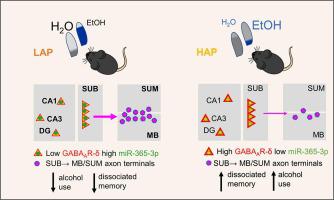Neurobiology of Learning and Memory ( IF 2.2 ) Pub Date : 2021-05-18 , DOI: 10.1016/j.nlm.2021.107459 Vladimir Jovasevic 1 , Jelena Radulovic 2

|
Alcohol use disorder (AUD) frequently co-occurs with dissociative disorders and disorders with dissociative symptoms, suggesting a common neurobiological basis. It has been proposed that facilitated information processing under the influence of alcohol, resulting in the formation of dissociated memories, might be an important factor controlling alcohol use. Access to such memories is facilitated under the effect of alcohol, thus further reinforcing alcohol use. To interrogate possible mechanisms associated with these phenotypes, we used a mouse model of dissociative amnesia, combined with a high-alcohol preferring (HAP) model of AUD. Dissociated memory was induced by activation of hippocampal extrasynaptic GABA type A receptor delta subunits (GABAAR-δ), which control tonic inhibition and to which ethanol binds with high affinity. Increased ethanol preference was associated with increased propensity to form dissociated memories dependent on GABAAR-δ in the dorsal hippocampus (DH). Furthermore, the DH level of GABAAR-δ protein, but not mRNA, was increased in HAP mice, and was inversely correlated to the level of miR-365-3p, suggesting an miRNA-mediated post-transcriptional mechanism contributing to elevated GABAAR-δ. The observed changes of DH GABAAR-δ were associated with a severe reduction of excitatory projections stemming from GABAAR-δ-containing pyramidal neurons in the subiculum and terminating in the mammillary body. These results suggest that both molecular and circuit dysfunction involving hippocampal GABAAR-δ receptors might contribute to the co-occurrence of ethanol preference and dissociated information processing.
中文翻译:

高乙醇偏好和分离记忆是与海马 GABAAR-δ 受体水平相关的共同表型
酒精使用障碍 (AUD) 经常与解离障碍和具有解离症状的障碍同时发生,这表明存在共同的神经生物学基础。有人提出,在酒精的影响下促进信息处理,导致分离记忆的形成,可能是控制酒精使用的一个重要因素。在酒精的作用下,访问这些记忆变得容易,从而进一步加强了酒精的使用。为了探究与这些表型相关的可能机制,我们使用了分离性健忘症的小鼠模型,并结合了 AUD 的高酒精偏好 (HAP) 模型。海马突触外 GABA A 型受体 δ 亚基 (GABA AR-δ),它控制强直抑制并且乙醇以高亲和力与其结合。增加的乙醇偏好与在背侧海马 (DH)中形成依赖于 GABA A R-δ 的分离记忆的倾向增加有关。此外,HAP 小鼠中 GABA A R-δ 蛋白的 DH 水平(而非 mRNA)增加,并且与 miR-365-3p 的水平呈负相关,表明 miRNA 介导的转录后机制导致 GABA 升高一个R-δ。观察到的 DH GABA A R-δ 变化与 GABA A引起的兴奋性投射的严重减少有关下托中含有 R-δ 的锥体神经元,终止于乳头体。这些结果表明,涉及海马 GABA A R-δ 受体的分子和电路功能障碍可能有助于乙醇偏好和解离信息处理的共同发生。











































 京公网安备 11010802027423号
京公网安备 11010802027423号